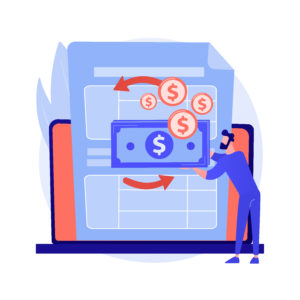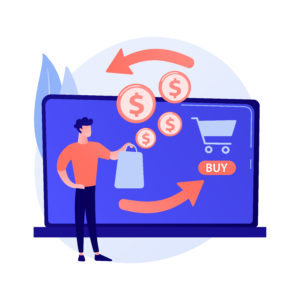Updated in March, 2022.
Disputes, chargebacks, and refunds can have a substantial effect on your revenue. The rise of eCommerce has made it easier than ever for unhappy customers to ask for a reimbursement. In the US, the second largest online retail market, approximately $102 billion worth of merchandise purchased online was returned in 2020. However, customers often choose not to request a refund. Instead, they initiate a dispute or a chargeback.
A Chargeback911 report published in 2021 suggests that chargeback cases have increased by an average of roughly 20% each year since 2014. Usually, the cost of chargebacks accounts for 0.47% of total merchant revenue. From a customer’s perspective, disputes, chargebacks, and refunds might seem like the same thing. Chargebacks can be a merchant’s worst enemy, however, because they often cost the business money and customers.
We’ve already shown you how to avoid chargebacks and lower your chargeback rate. In this post we’ll take a look at the differences between disputes, claims, and chargebacks, then touch on how to develop an effective refund policy that will help you grow your business without disruption.
Understanding PayPal Disputes, Claims, and Chargebacks
When your customers pay you through PayPal, they can open what’s called a dispute if they’re unhappy with a transaction. A dispute, which tends to be the easiest way to resolve an issue, involves direct communication between you and the customer while PayPal holds the funds.
You have 20 days to resolve a dispute. However, you should start working towards a dispute resolution as soon as possible. During this process, it’s important to communicate clearly and remain polite: don’t let things get heated! Keep an open mind and work together on finding a solution to the dispute – the customer usually wants to solve the issue as much as you do.

If you choose not to respond, or if you don’t agree on a resolution, the buyer can escalate the dispute to a claim, which means that PayPal will decide the issue based on documentation that you and the buyer provide. Once the claim is open, you have 10 days to send documentation and defend your case. If you fail to provide the evidence before the deadline, the buyer automatically wins the claim.
If PayPal decides a claim against you, you can appeal this decision but you’ll need to provide additional documentation. In fact, documentation of your policies and interactions with the buyer will be key throughout the dispute and claim process. The evidence requested to support your case will depend on the type of products or services your business offers:
- For physical products, you must prove that they were shipped to the right address and successfully delivered. You can provide a delivery slip, tracking code or ID number, or signature confirmation.
- For digital products, you need to show that the buyer downloaded or used the products.
- For services, you have to submit a signed contract, service agreement, or other documentation that testifies the service completion.
If a buyer isn’t happy with how PayPal decides a claim, they can then choose to go to their bank and initiate a chargeback for a disputed transaction. Once an issue reaches the chargeback stage, it’s no longer up to PayPal. Because chargebacks typically favor the buyer, it’s a good idea for you to resolve PayPal problems at the dispute or claim stage.
Bonus: Check out this eBook on how to better understand chargebacks and avoid them!
Are Disputes and Chargebacks Treated the Same?
When paying online, if a buyer is not happy with the transaction they can either open a refund request, file a dispute with PayPal, or initiate a chargeback with their bank.
What you want is for the customer to first open a refund request. To facilitate that, your contact details should be easily available to the customer. Most refund requests that are denied by you, the vendor, end up in a dispute filed with PayPal (which will become a chargeback if you refuse to issue the refund) or go directly to the chargeback stage. Prevent a dispute or chargeback from happening by promptly and professionally answering customers’ inquiries.
The two terms are sometimes used interchangeably, but commerce providers do not usually treat disputes and chargebacks the same way. They treat disputes as a refund request because they understand the negative impact disputes can have on their business. The difference between a chargeback and a dispute is the opportunity to solve the issue directly with the client through open communication and an agreement that benefits both of you.

At 2Checkout, we do the same. We provide responsive notifications to you, the vendor, and enable clear communication between your team, the customer, and PayPal throughout the process, creating a paper trail that you can rely on later if needed. No matter what happens, we want to be able to provide the right information.
The aim is to resolve as many disputes as possible and not let them reach the chargeback stage.
Setting a Smart Refund Policy
One of the best ways to protect yourself against disputes, claims, and chargebacks is to establish and enforce a clear refund policy. In 2021, over 20% of online purchases in the US were returned, with the total return rate for brick-and-mortar and online stores rising to 16.6%, as compared to 10.6% in the previous year. Nowadays customers want to be able to return their purchases and get a refund, but this doesn’t mean your business has to suffer. You can create a smart and clear refund policy that satisfies your customers and still makes your business profitable.
There are many refund policy tools out there that can help you with this, but the main elements your policy should include are:
- What items are eligible for a refund and what condition they must be in (unused, unopened, not downloaded, etc.)
- Why customers may apply for a refund (for defects or items not received)
- How to request a refund (email, phone, online, or other)
- When customers can request a refund (within 30 days of purchase is a typical timeframe)
- Who will pay for return shipping (you or the customer)
While setting up your refund policy, you should also consider shoppers’ expectations. In a 2021 research conducted by Klarna in the UK online market, 81% of respondents stated that they expect vendors to offer free returns. Covering the return shipping charge is an extra cost for your business, but it might help you avoid customer disputes, claims, and chargebacks.
Armed with these core elements, you can create a crystal-clear refund policy that works for you and your customers.
Reject Refunds with Caution
If you must reject a refund request, be sure you’re doing so for the right reasons and always act in line with your refund policy. You’ll want to be able to show that your customer’s problem has been addressed already or that the request violates the refund policy that the shopper agreed to by making a purchase. Once you decide to reject a refund request, inform the buyer of your decision. Communicate clearly and politely. Let the customer know that you’ve carefully considered the request and state the reasons that led to this decision. If you’re unsure about how to properly communicate your decision, use a template letter for denying refund requests and personalize it accordingly.
If you don’t have a solid, well-documented reason for rejecting a refund, you risk getting a chargeback on the transaction, thereby losing the value of the order as well as the time your team spent dealing with the issue.

What is Friendly Fraud or Chargeback Fraud?
One of the most common types of eCommerce fraud, known as “friendly fraud,” happens when a customer makes a purchase and then initiates a chargeback in order to receive a refund and remain in possession of the product. In 2021, merchants reported that 32% of registered chargebacks were chargeback fraud.
A friendly fraudster can claim that
- The payment wasn’t authorized or they don’t remember making the transaction
- The product wasn’t delivered
- It doesn’t match the online description
They can use a range of claims to testify that they deserve their money back. However, some of these claims might actually be true. As a merchant, you have a chance to fight the chargeback and provide documentation that counteracts the customer’s claims.
However, even if you win the chargeback case, your business will still be affected. To prevent chargeback fraud and keep your online business safe, you can set in place strategies for eCommerce fraud prevention.
Bonus: Check out this webinar to learn the best practices in combating payment fraud!
Chargebacks Versus Refunds: What is the Difference?
Chargebacks and refunds usually happen for the same reason: the customer is unsatisfied with their purchase and they want their money back. The main difference between a chargeback and a refund is the route the buyer takes to receive their funds back. Customers are usually expected to first contact the merchant, communicate their issues, and request a refund before going to the bank. A refund means a total transaction reversal where the buyer gets their funds back, and the items are returned to you, the vendor.
If a buyer chooses to involve the bank prior to talking to you, it’s likely they will be asked by the bank to try and solve the issue with you before requesting a chargeback. The chargeback results only in a payment reversal – the buyer receives their funds, but the items are not returned to you.
Another difference between chargebacks and refunds is the additional resources needed, especially from the merchant’s side. A chargeback requires additional documentation, paying fees, allocating extra time and human resources – all at the expense of your business. It’s simply better for both parties to solve the issue through a refund than to go through a chargeback case.
Refunds Can Be Your Best Friend
Because they help avoid chargebacks, refund requests can actually be your best friend. Think of these requests not as an inconvenience, but as an opportunity to work through a customer problem, keep the money, and create a happy customer. Taking the time to provide excellent service and resolve a problem to a customer’s satisfaction can actually make that customer happier than never having an issue in the first place. It communicates that you’re prioritizing their experience and focusing on building strong relationships with your clients.
In fact, the repeat purchasing rate is 17.8% higher for customers who get a refund compared to those who don’t return any products. If you treat your customer right during the refund process, it’s likely they will give you a second chance and become repeat customers.

Chargebacks Are Your Worst Enemy
On the other hand, the chargeback is clearly your worst enemy because it tends to cost you money and customers at the same time. By the time your customers are frustrated enough to resort to a chargeback, they don’t want to deal with you anymore and are willing to appeal to a higher authority to solve their issue.
The chargeback is different from a refund since you’re likely to lose this customer for life, not just for one transaction. Worse, the customer may share this negative experience with others, discouraging them from becoming your customers.
The chargeback ratio is also affected whether you win the chargeback or not. Both payment networks and payment processors view the chargeback ratio as a statement of how easily and safely your business can accept payments. Therefore there are chargeback thresholds imposed by card networks and processors. As of 2022, Visa requires merchants to have a chargeback ratio below the 0.9% limit, whereas Mastercard maintains a 1.5% threshold. If your business crosses the chargeback limits, you risk receiving extra fees, higher payment processing costs, or even getting your account closed with your processor. It’s in your business’ best interest to avoid chargebacks as much as possible.
To Sum Up…
With the rise in popularity of online purchases, disputes and chargebacks have become common methods for buyers to request their money back. As a merchant, you should treat an open dispute as an opportunity to understand the customer’s issue and avoid escalation to a claim or chargeback as much as possible.
However, you can prevent disputes by developing a smart refund policy that will encourage customers to ask for a refund instead. Think about the buyers’ needs and expectations when creating your refund requirements, and make them easily accessible on your website.
Now that you understand the differences between disputes, claims, and chargebacks, are you ready to create a refund policy that will help avoid them all? Tell us what you come up with in the comments!





